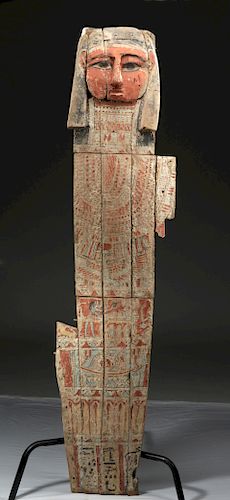Egyptian Painted Cedar Wood Frontal Coffin Cover
Lot 10b
About Seller
Artemis Fine Arts
686 S Taylor Ave, Ste 106
Louisville, CO 80027
United States
Selling antiquities, ancient and ethnographic art online since 1993, Artemis Gallery specializes in Classical Antiquities (Egyptian, Greek, Roman, Near Eastern), Asian, Pre-Columbian, African / Tribal / Oceanographic art. Our extensive inventory includes pottery, stone, metal, wood, glass and textil...Read more
Estimate:
$24,000 - $36,000
Absentee vs Live bid
Two ways to bid:
- Leave a max absentee bid and the platform will bid on your behalf up to your maximum bid during the live auction.
- Bid live during the auction and your bids will be submitted real-time to the auctioneer.
Bid Increments
| Price | Bid Increment |
|---|---|
| $0 | $25 |
| $300 | $50 |
| $1,000 | $100 |
| $2,000 | $250 |
| $5,000 | $500 |
| $10,000 | $1,000 |
| $20,000 | $2,500 |
| $50,000 | $5,000 |
| $100,000 | $10,000 |
| $200,000 | $20,000 |
About Auction
By Artemis Fine Arts
Sep 26, 2019
Set Reminder
2019-09-26 10:00:00
2019-09-26 10:00:00
America/New_York
Bidsquare
Bidsquare : Exceptional Day 1: Antiquities & Asian Art
https://www.bidsquare.com/auctions/artemis-gallery/exceptional-day-1-antiquities-asian-art-4437
Day 1 of an important 2-day auction featuring exceptional, museum-worthy examples of Egyptian, Greek, Etruscan, Roman, Viking, Russian, Near Eastern, as well as Asian Art from China, Japan, Thailand, Vietnam, Burma and India. Artemis Fine Arts info@artemisfinearts.com
Day 1 of an important 2-day auction featuring exceptional, museum-worthy examples of Egyptian, Greek, Etruscan, Roman, Viking, Russian, Near Eastern, as well as Asian Art from China, Japan, Thailand, Vietnam, Burma and India. Artemis Fine Arts info@artemisfinearts.com
- Lot Description
Egypt, Late Dynastic Period, 26th to 31st Dynasty, ca. 664 to 332 BCE. A wonderful example of a frontal coffin cover comprised of fifteen individual planks of finely grained cedar wood secured via several original dowels and dowel holes. The puffy face wears a simple bag wig and features almond-shaped eyes outlined in black pigment beneath slender brows, a wide nose, rounded cheeks, and full lips, all in a base red hue. The neck and chest are adorned with dense blue, red, and white pigment that forms necklace strands and an intricate wesekh-collar, and the bottom of the midsection displays the goddess Nut in a kneeling pose with outstretched wings. The sister goddesses Isis and Nephthys mourn on either side of the embalming table presided over by the jackal-headed god Anubis, with four canopic jars beneath the table, and a cobra-adorned funerary boat below. The bottom features several tall lotus blooms above three columns of untranslated hieroglyphic text. Size: 16.5" W x 70.3" H (41.9 cm x 178.6 cm).
Anthropoid Egyptian coffins first appeared by the Middle Kingdom - skillfully carved so as to outline the mummy's body and decorated with the visage and wig of the deceased individual. Such coffins not only served to copy the mummy's form kept within, but also served as actual substitutes for the bodies in the event that the mummy's body was lost or destroyed. As time progressed, these coffins were decorated with more extensive iconographic programs, presenting a greater number of inscriptions and scenes as we see in this example.
Interestingly, cedar wood was not native to Egypt. Egypt did not have verdant forests filled with tall trees, and unfortunately most of its native lumber was of relatively poor quality. Thus, they relied on importing to acquire hardwoods - ebony imported from Africa, cedar and pine from Lebanon. One fabulous obelisk inscription by Thutmose III attests to the luxury of treasured hardwoods. It reads as follows, "They brought to me the choicest products...consisting of cedar, juniper and of meru wood...all the good sweet woods of God's Land." The rarity of cedar meant that masks like this example were reserved for those who could afford them.
For a couple of examples showing frontal anthropomorphic coffin panels from the Middle Kingdom and New Kingdom, please see: Ikram, Salima and Aidan Dodson. "The Mummy in Ancient Egypt: Equipping the Dead for Eternity." Thames and Hudson, London, 1998, pp. 168, 172, figs. 193, 201.
Provenance: private J.H. collection, Beaverton, Oregon, USA; ex-Relics of the Nile, Lexington, Kentucky, USA; ex-private S.O. Simonian collection, Switzerland, acquired before 1972
All items legal to buy/sell under U.S. Statute covering cultural patrimony Code 2600, CHAPTER 14, and are guaranteed to be as described or your money back.
A Certificate of Authenticity will accompany all winning bids.
We ship worldwide and handle all shipping in-house for your convenience.
#149608Losses to areas of some peripheral panels, face, lower body, dowels, and dowels holes as shown. Fading to original pigmentation, with a few stable fissures, light abrasions, and expected desiccation commensurate with age. Great traces of original pigmentation throughout.Condition
- Shipping Info
-
All shipping is handled in-house for your convenience. Your invoice from Artemis Gallery will include shipping calculation instructions. If in doubt, please inquire BEFORE bidding for estimated shipping costs for individual items.
-
- Buyer's Premium



 EUR
EUR CAD
CAD AUD
AUD GBP
GBP MXN
MXN HKD
HKD CNY
CNY MYR
MYR SEK
SEK SGD
SGD CHF
CHF THB
THB















